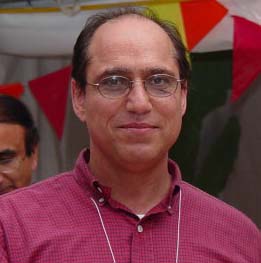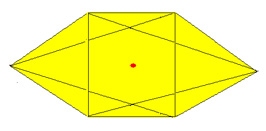Deyjehuor
its Meaning and its implied view of Kashmiri
Marriage
AUM
ParamaSivAaya NammaHa! AUM BhairVAaya NammaHa!
by Rabinder Koul
Introduction
As
part of Kashmiri marriage tradition Deyjehuor is  perhaps the most important of Kashmiri Bride’s
AabhUushan (Jewelry). Commonly, we say, it is
supposed to be a symbol of marriage for the
Kashmiri Ladies. It definitely serves that
purpose, but why this symbol should have been
construed to stand for the symbol of marriage, as
against the “Sindhoor” or “Mangala-Soutra”
used by almost every other population following
Vedic or Aagamic lineage? The answer to this
lays in the effort of our ancestors to encapsulate
the divine nature of reality in the parallels they
found in the routine daily life. In effect the
models of existence as experienced by them got
incorporated in a very deep way in ethical, moral
and social codes of daily life. In a certain sense
it goes far beyond the present day analog we find
on printed T-shirts our generations wear. (For
example often we see the T-shirts worn not only by
scholars but also by other young/old people on
which are printed the equations of Physics, or
some new concepts in Biology or Chemistry etc..)
perhaps the most important of Kashmiri Bride’s
AabhUushan (Jewelry). Commonly, we say, it is
supposed to be a symbol of marriage for the
Kashmiri Ladies. It definitely serves that
purpose, but why this symbol should have been
construed to stand for the symbol of marriage, as
against the “Sindhoor” or “Mangala-Soutra”
used by almost every other population following
Vedic or Aagamic lineage? The answer to this
lays in the effort of our ancestors to encapsulate
the divine nature of reality in the parallels they
found in the routine daily life. In effect the
models of existence as experienced by them got
incorporated in a very deep way in ethical, moral
and social codes of daily life. In a certain sense
it goes far beyond the present day analog we find
on printed T-shirts our generations wear. (For
example often we see the T-shirts worn not only by
scholars but also by other young/old people on
which are printed the equations of Physics, or
some new concepts in Biology or Chemistry etc..)
I
would like to point out that the roots of this
symbol, Deyjehuor, are in the Spiritual
experience of a Yogi, in YAamla (union) of Siva
and its Shaktee, which are non-distinct from each
other. To understand this clearly, I will follow
the following seven steps. In the first step,
1.
The shape of Deyjehuor will be explained for those
who may not have noticed it or may not have seen
it. After that
2.
A short introduction to categories of Advaitic-Siva
a-la PratyabhijnyAana will be provided. Following
that we will,
3.
Introduce the notions of the four states of
consciousness/existence. And relate highest state
to the state of ParamaSiva and the categories of
PratyabhijnyAana. We will next,
4.
Introduce the notion of Kundalini, functional
aspects of Kundalini, its states and relate it to
Vimarsini/Shaktee. And its relation to highest
state of existence. Next we will,
5.
Introduce Chakras and Bindu the main spiritual
centers of the microcosmic Human Body and the
process of Kundalini Yoga, the Trikona and
Shatakona. Having understood the above five we
will,
6.
Describe the experience of Kundalini as it rises
and the joining of two TriKona’s in
BrahamrandraDhAara. After that we will
7.
Relate this state in BrahamrandraDhAara with
Deyjehuor.
The shape of a
Deyjehuor
The
perimeter of the facial projection of a Deyjehuor
on a plane is hexagon (Shatakona). The face of
this hexagon carries a Bindu (dot) at the center.
This Bindu appears in the center of a regular
Deyjehuor as tiny red or white colored
semi-precious or precious stone, called CHUUNE in
Kashmiri. In total along with the central point
“CHUUNE” Shatakona has seven points. In the
following we will try to under-stand what is the
relevance of this shape and the CHUUNE in its
center (Figure below):

Projection of a DEYJEHUOR
To
understand the root significance of Deyjehuor we
will have to take a slight detour to understand
certain Concepts in which Advaitic-Siva is
understood.
The
Categories I will use are primarily from the
PratybhijnnAa. The Advaitic-Siva in PratybhijnnAa
is described the reality which is one without the
second. This one reality is called
PraKAasa-Vimarsini. This compound name is really a
compound characterization of one reality. It is
further added that this PraKAasa and Vimarsini are
not separate or distinct from each other. In fact
these aspects can not be separated from one
another. The analogy given is that of Fire and
Heat, (Please keep in mind that these are only
analogies are only direction pointers) which can
not be separated from each other.
What
is being said is that reality is PraKAasa, and
unlike ordinary PraKAasa, this PrakAasa is self-
aware. Self-awareness here has been used for the
technical term of Vimarsini. The closest English
term corresponding to PraKAasa is Light and the
closest term to Vimarsini is the Awareness of
consciousness. Thus from this point ultimate
existent is Light, not an ordinary Light, but
Light which is self-Aware. In this context
PraKAasa should be understood as that which
lights-up (as in a meaning, or as in ordinary
light some thing is brought forth,.. “Ah! That
is It.”). That is as a source of cognition. (The
simplest example would be ordinary Consciousness,
which gets manifested by the Awareness. As
awareness of the limited self, or glass, etc.)
Notice that even ordinary Awareness can be shifted
from one limited object to the other, bringing
forth that particular object in to
‘manifestation’, or it can fold back and focus
on to the self. Even in ordinary routine life the
awareness becomes the outer manifestation of the
inner individual Consciousness.
The
PraKAasa is thus an unchanging transcendent aspect
of that one reality and Vimarsini the changing,
immanent aspect of the same one reality. However
these transcendent and immanent aspects are not
and can not be separated from each other.
(Notice this contradictory transcendence and the
immanence is held together with out a difference
and is the reason why Advaitic-Siva is
simultaneously both realistic and idealistic.) In
Sanskrit language the PraKAasa has masculine
gender hence is “HE” aspect, also called Siva.
Where as Vimarsini in Sanskrit language has
feminine gender hence called the “SHE” aspect.
Vimarsini (Awareness) because of being able to be
Sankuchit (limited) and as well as Visa
(universal), is hence called Immanent. It is
this aspect which manifests both the limited
aspects and the universal aspects. And because of
that Vimarsini is called Shakti, for it alone
manifests both the limited and the universal
aspects. PraKAasa being unchanging transcendence.
(Keep in mind that it is not different from
PraKAasa. The highest state of this reality is
called ParmaSiva.) The message from here I want to
take forward is that of (Vimarsini) the
characterization of Shakti.
| 